
A wet nurse is a woman who breastfeeds and cares for another's child. Wet nurses are employed if the mother dies, or if she is unable or chooses not to nurse the child herself. Wet-nursed children may be known as "milk-siblings", and in some cultures, the families are linked by a special relationship of milk kinship. Wet-nursing existed in cultures around the world until the invention of reliable formula milk in the 20th century. The practice has made a small comeback in the 21st century.

A nanny is a person who provides child care. Typically, this care is given within the children's family setting. Throughout history, nannies were usually servants in large households and reported directly to the lady of the house. Today, modern nannies, like other domestic workers, may live in or out of the house, depending on their circumstances and those of their employers. Some employment agencies specialize in providing nannies, as there are families that specifically seek them and may make them a part of the household.

A domestic worker is a person who works within a residence and performs a variety of household services for an individual, from providing cleaning and household maintenance, or cooking, laundry and ironing, or care for children and elderly dependents, and other household errands. The term "'domestic service" applies to the equivalent occupational category. In traditional English contexts, such a person was said to be "in service".
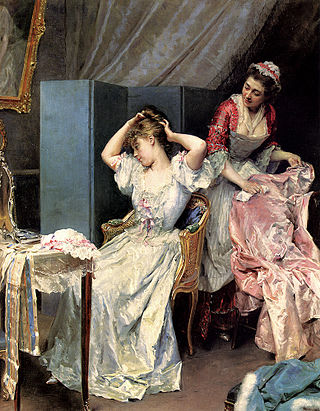
A maid, housemaid, or maidservant is a female domestic worker. In the Victorian era, domestic service was the second-largest category of employment in England and Wales, after agricultural work. In developed Western nations, full-time maids are now typically only found in the wealthiest households. In other parts of the world, maids remain common in urban middle-class households.

A butler is a person who works in a house serving and is a domestic worker in a large household. In great houses, the household is sometimes divided into departments with the butler in charge of the dining room, wine cellar, and pantry. Some also have charge of the entire parlour floor and housekeepers caring for the entire house and its appearance. A butler is usually male and in charge of male servants while a housekeeper is usually a woman and in charge of female servants. Traditionally, male servants were better paid and of higher status than female servants. The butler, as the senior male servant, has the highest servant status. He can also sometimes function as a chauffeur.

A mammy is a U.S. historical stereotype depicting black women, usually enslaved, who did domestic work, including nursing children. The fictionalized mammy character is often visualized as a dark-skinned woman with a motherly personality. The origin of the mammy figure stereotype is rooted in the history of slavery in the United States, as slave women were often tasked with domestic and childcare work in American slave-holding households. The mammy caricature was used to create a narrative of black women being happy within slavery or within a role of servitude. The mammy stereotype associates black women with domestic roles and it has been argued that it, combined with segregation and discrimination, limited job opportunities for black women during the Jim Crow era, approximately 1877 to 1966.
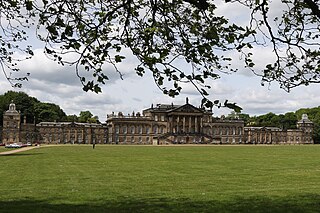
A great house is a large house or mansion with luxurious appointments and great retinues of indoor and outdoor staff. The term is used mainly historically, especially of properties at the turn of the 20th century, i.e., the late Victorian or Edwardian era in the United Kingdom and the Gilded Age in the United States.
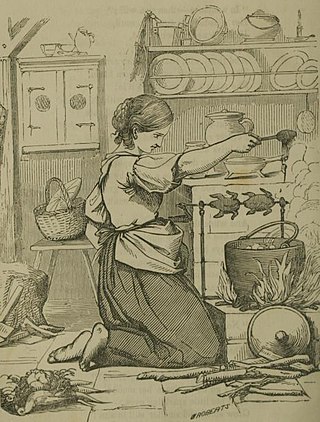
A cook or private chef is a household staff member responsible for food preparation.

A housekeeper is an individual responsible for the supervision of a house's cleaning staff. The housekeeper may also perform the cleaning duties themself.

Many have seen the status of women in the Victorian era as an illustration of the striking discrepancy between the United Kingdom's national power and wealth and what many, then and now, consider its appalling social conditions. During this era, whose sobriquet refers to the reign of a female monarch, Queen Victoria, women did not have the right to vote, sue, or if married, own property. At the same time, women labored within the paid workforce in increasing numbers following the Industrial Revolution. Feminist ideas spread among the educated middle classes, discriminatory laws were repealed, and the women's suffrage movement gained momentum in the last years of the Victorian era.
A between maid was a female junior domestic worker in a large household with many staff. The position became largely defunct in the 20th century, as few households needed or could afford great retinues of domestic workers with the elaborate hierarchy of the past.

In great houses, scullery maids were the lowest-ranked and often the youngest of the female domestic servants and acted as assistants to a kitchen maid.
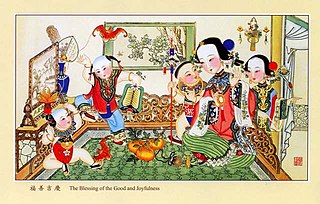
An amah or ayah is a girl or woman employed by a family to clean, look after children, and perform other domestic tasks. Amah is the usual version in East Asia, while ayah relates more to South Asia, and tends to specifically mean a nursemaid looking after young children, rather than a general maid.
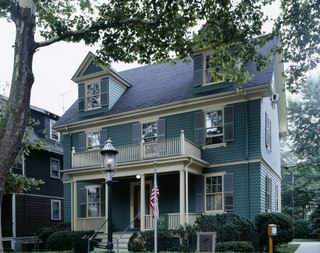
The John Fitzgerald Kennedy National Historic Site is the birthplace and childhood home of John F. Kennedy, the 35th president of the United States. The house is at 83 Beals Street in the Coolidge Corner neighborhood of Brookline, Massachusetts. Kennedy is one of four U.S. presidents born in Norfolk County, Massachusetts. The property is now owned by the National Park Service; tours of the house are offered, and a film is presented.
Maid service, cleaning service, apartment cleaning and janitorial service are terms more modernly describing a specialized outside service, providing a specific service to individuals, businesses, fraternal clubs and associations as well residential premises.
A lady's companion was a woman of genteel birth who lived with a woman of rank or wealth as retainer. The term was in use in the United Kingdom from at least the 18th century to the mid-20th century but it is now archaic. The profession is known in most of the Western world. The role was related to the position of lady-in-waiting, which by the 19th century was applied only to the female retainers of female members of the royal family. Ladies-in-waiting were usually women from the most privileged backgrounds who took the position for the prestige of associating with royalty, or for the enhanced marriage prospects available to those who spent time at court, but lady's companions usually took up their occupation because they needed to earn a living and have somewhere to live. A companion is not to be confused with lady's maid, a female personal attendant roughly equivalent to a "gentleman's gentleman" or valet.

A nursery is a bedroom within a house or other dwelling set aside for an infant or toddler.

The institution of slavery in North America existed from the earliest years of the colonial history of the United States until 1865 when the Thirteenth Amendment abolished slavery throughout the United States except as punishment for a crime. It was also abolished among the sovereign Indian tribes in Indian Territory by new peace treaties which the US required after the Civil War.
Women's work is a field of labour assumed to be solely the realm of women and associated with specific stereotypical jobs considered as uniquely feminine or domestic duties throughout history. It is most commonly used in reference to the unpaid labor typically performed by that of a mother or wife to upkeep the home and children.
Filipino domestic workers in Canada are Overseas Filipino Workers who frequently immigrated through the Live-In Caregiver program, which was cancelled to new applicants in 2014. After immigration processes and approval "the Live in Caregiver Program required of participants that they work as a live-in caregiver for two full years before applying for an open visa ". Many Filipinas found this program attractive because of their need to provide for their families, especially children. One of the main ways to provide for their children is giving them proper education. Highly valuing this, "a larger proportion of the mostly women who have come through these programs have come from the Philippines; by 1996 fully 87 percent came from the Philippines."















